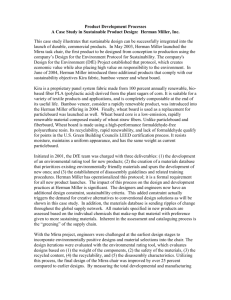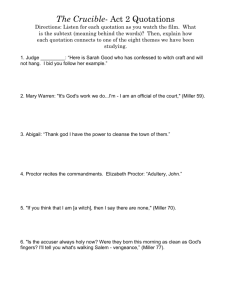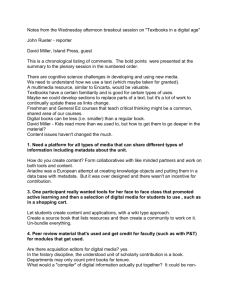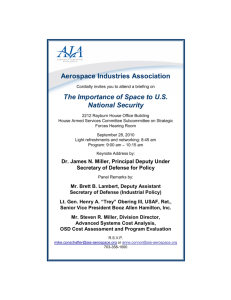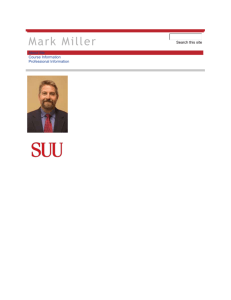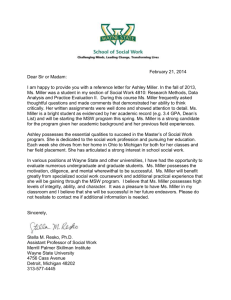File - Daniella Comito
advertisement
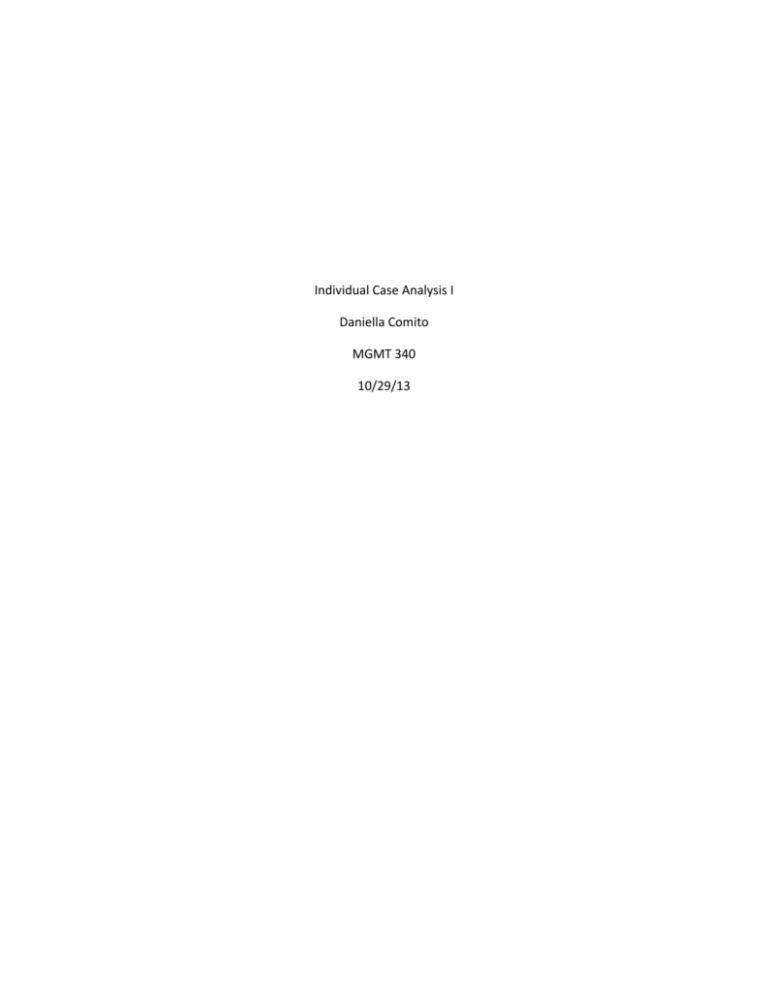
Individual Case Analysis I Daniella Comito MGMT 340 10/29/13 1) Based on Herman Miller’s external opportunities and threats, what strategic actions might they take? Review Herman Miller in relation to the competitive forces model and determine what strategic actions might be viable. Threats: Threat 1: The Telecommunication Trend This trend shows that more and more employees around the world are telecommuting, which means that they are working from areas other than the office. This indicates that their employers need less office equipment. This is a threat to Herman Miller because they want employers to buy office equipment. Threat 2: New Competition from Emerging Nations Herman Miller is a global company that sells their products to many different countries around the world. This provides a threat of new competition from emerging nations. Herman Miller does not only need to be aware of what happens in the industry in the U.S. but it also needs to watch competition in other countries as well. Threat 3: The Recession The recession is a macroenvironmental threat. This is a threat because the office equipment industry was hit hard by the recession, therefore affecting Herman Miller. The company runs in many other countries including the U.K., which has also not recovered from the recession fully. Herman Miller should keep an eye on the economies of all the countries they operate in. Opportunities: Opportunity 1: Employees are Spending More and More Time in front of Computers This trend is an opportunity for Herman Miller because this means that there is now a high demand for office furniture that is ergonomically correct. As employees spend more time sitting and staring at computers, they need furniture that will decrease fatigue and injuries. Opportunity 2: The Telecommuting Trend This trend is not just a threat; it is also an opportunity because Herman Miller could look at this as a new market segment/niche. Herman Miller could offer a product line that is tailored to the telecommuter, this would be a product differentiator with a focus on the “at home office.” Opportunity 3: Herman Miller’s Comprehensive Program Designed for a “Better World around You” There is an opportunity for Herman Miller to expand upon this goal. With such a focus on healthy living for their employees, the company could implement office equipment that is designed around health and not just ergonomics. They could come up with office furniture that includes standing or treadmill desks etc. Competitive Forces Model: Risk of Entry by Potential Competitors: This entry risk is high because the barriers to entry are low for this industry and there are many local and global competitors. The start-up is costly (to get a location, building and utilities). Overall Page | 1 there aren’t strong government regulations, there is a low customer switching cost and no one company has an absolute cost advantage. All of this together makes for a strong competitive force. Bargaining Power of Suppliers: The power of suppliers is medium. The artists and innovators that Herman Miller hires to come up with product designs are a unique commodity, giving them high power. On the other hand, suppliers that deliver inventory to Herman Miller and companies that they outsource component parts to are not unique and do not have a high switching cost, giving them low power. Bargaining Power of Buyers: This risk is high and the buyers are the companies that purchase Herman Miller’s office equipment and these buyers are a large part of their total orders. There are many substitutes with similar prices for the buyers to choose from, giving them a lot of power. These companies usually buy in large a quantity, which gives them a leverage to ask for price reductions. Substitute Products: This is a strong competitive threat because close substitutes exist. A company can choose from many different types of chairs, tables and office accessories to satisfy the similar needs of comfortability, functionability and style. Having many substitute products available limits Herman Millers pricing options and limits industry profitability. Rivalry among Established Companies: With all of these threats considered (a high risk of entry, medium supplier power, high buyer power and high substitute risk) the rivalry among established companies is high. There is a high demand which generally reduces rivalry, but this is a consolidated industry which has high rivalry because the companies are interdependent of each other’s competitive actions. Nonetheless, Herman Miller is fighting this high rivalry with their innovative product designs. Viable Strategic Actions: Action 1: Invest In R&D for Trends It would be beneficial for Herman Miller to look further into the possibility of creating a new market segment with either of the trends discussed prior. If the company invested in creating a line for the “in home office” equipment it would satisfy the trend of telecommuting. It would also take advantage of an opportunity, as well as eliminate a threat. If the company decided to invest further into creating ergonomically correct furniture to satisfy the trend of employees spending more time in front of computers and this would support their “better world around you” initiative. Investing in this research would give Herman Miller a competitive advantage within the industry. Action 2: Initiate Health Wellness Stations at Work If Herman Miller began to create office equipment that was focused on health wellness, it would again support their “better world around you” initiative. Herman Miller has always honored having their employees as high importance. Implementing new types of office equipment could improve employee health and eventually be added as a new product line for their business. Some examples are: mobile work stations, standing desks or treadmill desk. This would create product differentiation for the company. Page | 2 2) What impact does the industry life-cycle have upon the future of Herman Miller? Herman Miller is in a mature industry life cycle. The companies in this industry have been able to create brand loyalty, as well as efficient low-cost operations. Even though the company is in the mature stage of the life-cycle they are still able to create some growth. Herman Miller displays a strong research and development department, happy employees and award winning products. The company has survived the Great Depression, September 11th and is performing well in the current recession. With all of this, it seems safe to say that being in a mature industry will not have a negative impact on Herman Miller in the future. If the company continues to follow trends and create innovative designs through their employee’s “collective spirit”, then they will continue to excel within the industry. 3) Examine Herman Miller for its strengths and weaknesses including its core competencies, resources, and capabilities. What implications do they have for Herman Miller and its strategic direction? Strengths: Strength 1: Marketing One of Herman Miller’s strengths is their marketing. They have a global presence and have integrated innovative marketing techniques. An example of this is, the hotels that have their furniture also have a website with that furniture available for customers to purchase. Strength 2: Being Environmentally Friendly The company was one of the first to really focus on being environmentally friendly. This is a growing trend among other companies and also among investors and customers. Customers are beginning to be more aware of this, leading them to choose “green” companies over other nongreen companies. This is also used as a successful marketing because builders who use Herman Miller products earn LEED points. Strength 3: Herman Miller’s Human Resource Management Herman Miller has a strong human resource management department, which is a strength. The company is on Fortune’s 100 Best Companies to Work For consistently and for every one open job position, they generally had 278 applicants for it. These two examples display the success of their human resource management. Weaknesses: Weakness 1: “Just In Time” Inventory This has proven to work well for Herman Miller, giving them cost savings and helping to maximize efficiency, but this can also be seen as a weakness. Using JIT inventory makes the company more sensitive to not being able to fill orders in times of distress. For example, if their supplier is located in a different area where a natural disaster occurred, Herman Miller would then not have the inventory on hand to fulfill orders until their supplier got back on its feet. Weakness 2: Prices of Materials Raw material prices are costly and if they were to raise this would greatly affect the company’s operating cost/margins. Page | 3 Weakness 3: 20% of Profits come from Non-North American Countries This could be considered a weakness for Herman Miller because it means that 80% (statistic taken in 2007) of profits are coming from North American countries that are currently suffering from a recession. On the other hand, 20% of their profits are coming from non-North American countries, making them vulnerable to many other different economies performances. Core Competencies: One of the major core competencies is Herman Miller’s employee loyalty. The company offers many common benefits, but they also offer many unique ones. An example of this is their 100% tuition reimbursement offered. Another core competency is Herman Miller’s employee empowerment. This is demonstrated through how they implement “talking up and down the latter.” All employees are encouraged to bring forth ideas. Resources: Herman Miller has many different resources that they can use in order to function effectively. Some resources are: money, employees, materials/products, the Herman Miller Performance System, Green House Production Facility, and company shares/equity. Capabilities: Herman Miller has many capabilities that help them perform core functions. Some capabilities are: human resource management, financial management, Toyota supplier support center, and a collective team spirit/culture. Implications on Herman Miller and its Strategic Direction: The conclusion that can be drawn from this analysis is that Herman Miller is overall a very strong company with a good strategic direction. The company has many more strengths, resources, capabilities and competencies among the ones that have been previously discussed. The company has a voluntary turnover of less than 2% and employees that respected how they conducted layoffs. These are obvious examples of a truly pleased work force. Having a happy work force means that Herman Miller has a big resource that is ready to perform well. The company has directly aligned the employees’ interests with the companies by tying compensation to company performance. This supports their strategic direction of putting customers first and having a profitable business. The company’s successful marketing and tied in environmental friendly initiative also adds to the success of the company. As for the weaknesses, there are not many more than the ones that have been previously discussed besides the sensitivity to economy performance. Having JIT inventory can be a weakness but only in times of an uncontrollable situation. Overall their inventory choice helps them save money and produce products efficiently. The cost of materials and performance of economies are also uncontrollable factors, but Herman Miller has proven that they are able to prevail during difficult economies; this has been shown through the Great Depression, the Dot.Com Bust and the Great Recession. Having profits come from non-North American counties can also be seen as a strength because they are not too dependent on any one country and have an expansive amount of customers, which helps them generate profits. Overall, Herman Miller is a stable company. Page | 4 4) If Herman Miller should take on a new strategy, how would they approach changing their business model? If Herman Miller should take on a new strategy, they should not entirely change their business model. Instead they should be certain that their new strategy works together with current strategies. If this is done it will ensure that all the strategies work together as one entity, giving the company a competitive advantage that will help create profit growth. A business model is meant to encompass all strategies and show how a company is unique from its rivals. The business model that Herman Miller currently uses is based on the idea that focusing on its customer needs is top priority. It used to be that Herman Miller based its initiatives on pleasing their employees, but they eventually had to switch in order to generate more profits and become the company it is today. As an example, if Herman Miller implemented my suggested strategic action of creating a “home office” product line, this new strategy would successfully fit its current business model and products. This strategic action would be finding fresh customer needs as new trends emerge and still fits under office equipment products; it would just simply be further differentiating the company’s product offerings. This new strategy would also give them the competitive advantage and possible profit growth that a business model is set up to create. If that specific strategic action was chosen, the business model would change a little bit, in the sense that it would be widened. The company would be broadening their customer base from employers ordering in bulk to single employees ordering for their home office. This creates new value for the company in acquiring new customers. This will help the company grow over time and hopefully achieve a high level of profitability through continuing to add innovative products through new strategies. 5) What global and industry characteristics must Herman Miller consider when aligning a new business model? Herman Miller must consider both global and industry characteristics when aligning new strategies into their business model. One characteristic of the industry is that it is mature, therefore the company should consider how much room is left for growth and if there are any untouched markets left within the industry that the company could use for expansion. Another industry characteristic are the trends that occur; continuously watching industry trends to try and remain to be innovators is key. Herman Miller should also still consider the characteristic of continuing with being green because the company is currently dealing with renewable and non-renewable resources and eliminating the non-renewable would be green and overall beneficial. The industry is also very competitive and sensitive to the economy. It is important for Herman Miller to consider the health of the economy as well as what its competitors are doing in order to have a successful business model. Since Herman Miller is a global company that produces and sells their products in many countries, they must also consider global characteristics. One global characteristic is the different economies. Herman Miller needs to always be aware of the economies it works in because the industry is very sensitive to economy performance. Having many economies to watch and be aware of can be difficult but it is still important. Another characteristic is the different cultures that are across the globe. It is vital for the company to research these diverse cultures in order to successfully market and create products for different countries. Different global countries may also have different trends than the U.S. and it will be important to be up to date on those as well. Page | 5
